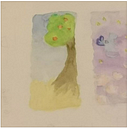goldfish (gouache) [1/100]
Warning! Long exposé on the qualities of watercolors and gouache follows. Wow, how can she go on for so long on such a topic, you’ll think to yourself …
To get into watercolors and gouache, I’ve been watching Youtube videos. I found this one really helpful and easy to understand for how to use watercolors (wet on wet v. wet on dry):
You might not expect it from the product (heh), but I actually took an Illustration class once when I was studying abroad in Florence where the primary medium was watercolor. Our professor was a great fan of the talented children’s book illustrator Roberto Innocenti, and she insisted as beginners we try to learn watercolors using his particular, rigorous method.
This method consisted of carefully drawing a bead of water paint from one starting point to fill an entire section using strokes of the same direction, being quick to prevent the water edge being pushed to fill the area from getting too dry before reaching the end. Not to mention being careful to avoid marring precious watercolor paper with damaging oils by not to resting your arm or hand on the paper at any time. :-)
Essentially, this achieved a flat, uniform wash without ugly stroke marks or patches with visible boundaries, with the idea that once we mastered the fundamentals with discipline, we could progress to blending colors and fancier techniques. As you can imagine, the larger the area to paint with one color, the harder this technique was (you have to paint very rapidly!).
I was terrible at grasping this technique, probably because I couldn’t figure out that I needed to use more water and maybe a bigger brush to paint without things drying out. My room mate, a graphic design major who was also taking the class and had used watercolors before, witnessed me struggle and told me with mercy that there are different methods of watercolor painting and this method of watercolor is not the only way to learn how to use them.
In retrospect, I do appreciate the introduction to watercolors that class gave me, because I had no concept of how exacting and demanding watercolor technique can be. I had no concept of technique in watercolor, at all, in fact — think of when you’re a kid in kindergarten, and the teacher pulls out watercolor palettes and just tells you to mix the paint with water and have at the canvas. That was about my knowledge of how to use watercolors.
I didn’t manage to make anything beautiful with watercolors in that class, but it was my starting point for further exploration in watercolors on my own, so the instructive experience is still very precious to me. I do, however, think that it’s good to allow beginners to enjoy and explore the medium a bit to learn how it feels natural and build an intuition of a medium first (the counterargument of the professor being that it’s bad to allow beginners to learn bad habits), and that’s the approach I take on my own.
Watercolors are dear to my heart because when you have familiarity with the process behind a medium, you can appreciate the artistry and beauty of a piece all the more. (It’s the same for me for ceramics! All the ubiquitous pottery is more interesting to me for having taken ceramics classes before.) I love how watercolors can be translucent and layered, and mixed together to produce beautiful gradients. Besides, they’re really accessible for a hobbyist in that you just need some quality paper, any cheap watercolor palette, a brush, and some water.
I was intrigued by gouache because they were a purported close watercolor neighbor, and therefore similarly accessible to me. Gouache is interesting because it has some sort of duality, at least to my perceptions, in that it can be a flat, matte paint that can make opaque layers (covering layers underneath), but it can also be diluted with water to achieve a more watercolor-like effect, with the marbling and translucent qualities.
I also love the vibrant colors of gouache — they can hold a lot more pigment than watercolors — and gouache dries quickly. It’s a really flexible medium that I’ve enjoyed playing with, and I think the majority of my paintings will be in gouache for this reason. Because of my background with watercolors, I mostly use it like watercolor, but I hope someday in the future to try more vector-like matte paintings and layering.
For now, the aforementioned video seemed like a good start. My goal was to play with wet on wet and wet on dry techniques, and fancy goldfish seemed like a suitable subject for blending colors. As you can see in the photo, it’s not really clean and there’s some messy details, but maybe if I paint 10 more goldfish, I’ll be able to make some pretty goldfish by the end. :)

